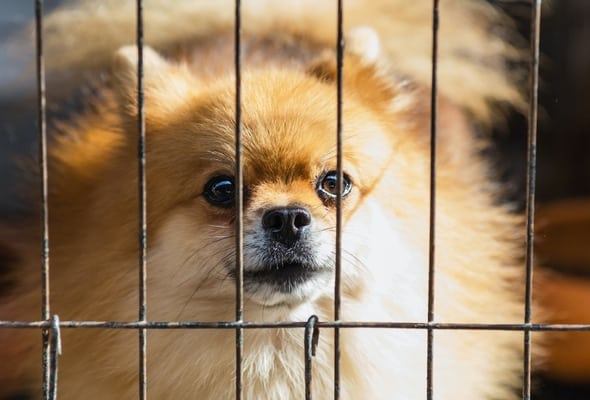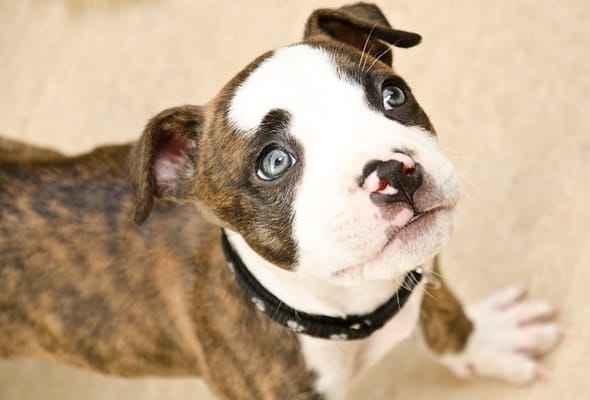Have you recently added a new furry best friend to your life but have no clue how to stop them from having any accidents in the house? We have compiled a list of 9 helpful tips to aid you with potty training your pup!
How to Stop a Puppy from Pooping in the House
Before we dive in, you will need to have a few supplies handy: your pup’s favorite treats, and a whole lot of patience.
Potty training has no set timeframe for results, it varies for each puppy and can take anywhere from 4 weeks to 1 year in some cases. Try not to worry too much, after reading these tips, you will have a great foundation to build your potty training routine!
1. Create a Feeding Schedule
Your first tip is to create a feeding schedule that lines up with the times you are available to bring them out to potty the most frequently. It is generally recommended to split your puppy’s daily food intake into 3 separate feedings.
For example, if your puppy has to eat 2 cups of food a day you would feed them 1 cup of food during the time that you are home the longest, and break the other 2 feedings into ½ cup each. Let’s say you aren’t home from 9 am – 4 pm, you could create their feeding schedule like this:
- ½ cup of food at 6 am
- ½ cup of food at 4:30 pm
- 1 cup of food at 6:00 pm
2. Create a Designated Area for Potty Breaks
This is an extremely important step when creating a potty training plan. When you bring your pup outside to relieve themselves, make sure you bring them to the same area every time.
This could be a certain corner in your garden, a puppy pad on your balcony, or whatever works best for you. When you arrive in their designated area, you want to say a command, like go potty every single time they are brought there.
This allows your puppy to easily recognize a pattern and will help when your puppy begins to mature so they can let you know when they need to potty.
3. Best Times For Potty Breaks
Potty training works best when you bring your puppy out to their designated spot as frequently as possible. Puppies don’t immediately understand holding their pee and poops, so accidents will be frequent until their training is established.
It is recommended to bring your puppy out to potty every 15-30 minutes, after every meal, after every nap, and anywhere in between. Consistency is key when training your pup to perform any task, and it is especially important during the potty training process.
4. Crate Training
If you aren’t able to be at home constantly during your pups’ potty training, crate training is a great option for you.

Despite what some may think, puppies can thoroughly enjoy being in their crates, and if trained properly will even use it as a form of comfort and safety. It is important to never begin crate training by just locking your pup up and leaving them alone for hours on end.
This is a delicate process, you have to associate positive feelings and experiences for crate training to be effective. There are great, free crate training videos widely available on the Internet.
5. Rewards and Praise
This is probably the most important tip on our list. Rewarding and praising your puppy when they exhibit the behavior you want (i.e pottying outside) or it will take forever to properly train them.
When your puppy relieves itself in their designated area, make sure that you verbally praise them (good boy/girl) in the most friendly and exciting voice you can muster, and immediately give them their favorite type of treat.
This reinforces in your puppy’s brain that when they perform the desired behavior, they will get rewarded lavishly and makes them more eager to please you.
6. Learn to Speak Dog
As your puppy gets more confident in their ability to please you, they may begin to exhibit signs that allow you to indicate that it’s time for a potty break.

If your pet generally goes through a door to get outside to their designated area, you may notice them begin to stand and whine at that door or try to get your attention in other ways.
Learning your puppy’s cues allows for better results, as they are indicating to you when they need to go. Always ensure that you do not wait too long to let them out, or they may have an accident.
7. Reinforcement
It is really important to reinforce your puppy’s potty training throughout their entire life. When your puppy indicates that they need to go outside, ask them if they need to go potty! This is such a simple practice but is extremely effective.
Make potty breaks an exciting event for your puppy and they will be even more motivated to exhibit the desired behavior. Every time your puppy relieves themselves and you see it, praise and reward them just as lavishly as you did when they were just beginning their training!
8. Puppy Deworming
If your puppy seems to be understanding the idea behind potty training but seems to be consistently pooping in the house, it is worth a shot to bring them to their primary veterinarian to be checked and (if needed) treated for intestinal parasites.
Don’t worry, most puppies are born with some form of intestinal parasite, and as long as they are treated in adequate time they are generally easily treatable. Your puppy should be visiting a veterinarian every 3 weeks for routine fecal exams and puppy vaccinations from 6 weeks of age up to 12 weeks of age.
Keep in mind that some vaccines are legally required in most states, so make sure you check up on your state’s companion animal laws.
9. Proper Puppy Diet
A well-balanced diet is essential for a healthy and happy pup. Some puppies may have sensitive stomachs and a good quality puppy kibble is extremely important for your pup’s GI health. Puppies must eat food that is formulated for puppies, as they require a higher calorie intake than adult puppies do.
Most veterinarians will recommend Hills Science Diet, Purina ProPlan, and Royal Canin, as these are reliable brands with high-quality puppy foods at varying price points.
Summary
We covered a range of helpful tips that you can use while potty training your puppy, but you can use these in conjunction with just about any form of training you and your puppy may explore.
If you feel that you need more help with this topic, exploring working with a professional puppy trainer may be a good option for you – they are widely available through multiple different platforms at a variety of price points.
If you are more of a visual learner: YouTube is always a great source when it comes to walk-through training processes!

